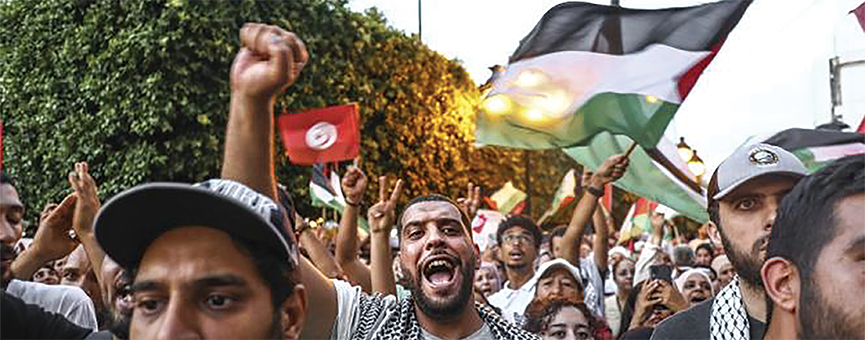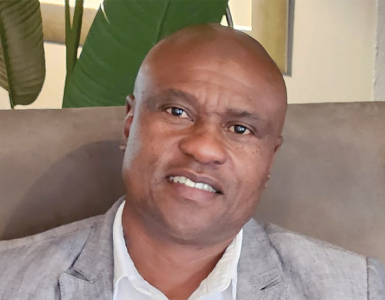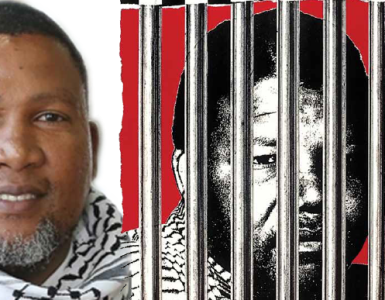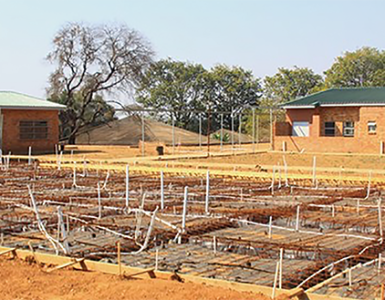RESILIENCE: The ‘Sumud’ convoy from Tunis to Gaza is reviving the radical promise of pan-African solidarity and reclaiming an anticolonial tactic lost to history.
By Joy Wang
On June 9, a convoy of dozens of buses and hundreds of cars carrying several thousand volunteers departed from the Tunisian capital city of Tunis on a more than 2 500km journey to the Rafah border crossing between Egypt and Palestine.
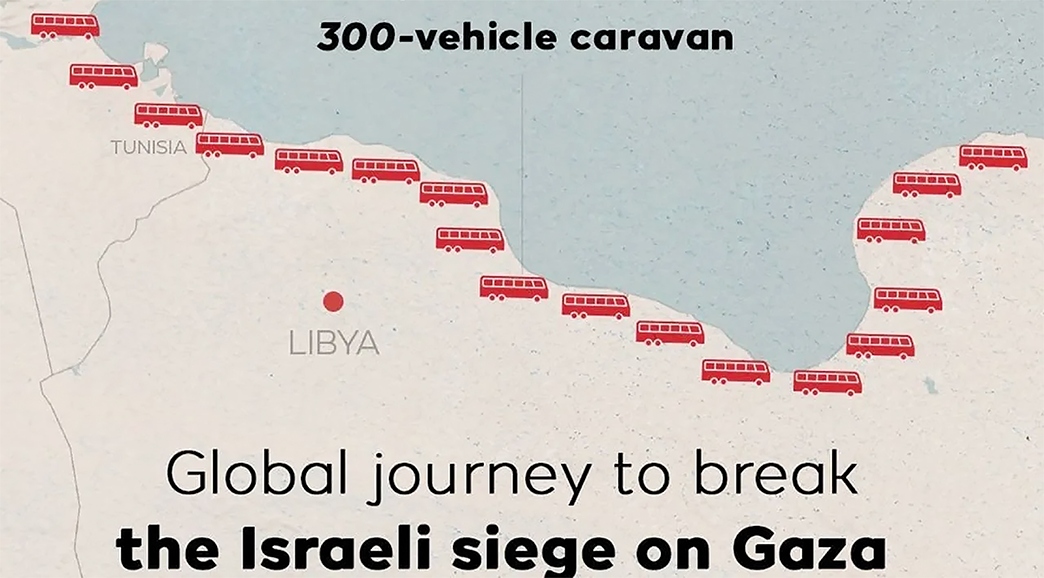
Dubbed the “Sumud” Convoy for its message of steadfastness and resilience, the convoy has been organised by a coordinating committee of Tunisian trade unions and civil society groups. It is comprised of volunteers from across the Maghreb as well as Global North solidarity delegations who will join the convoy in Cairo for the final leg of the Global March to Gaza.
Host to a team of medical professionals and carrying a symbolic quantity of food and medical supplies, the convoy aims to break Israel’s lethal siege on Gaza, where the occupation forces ongoing genocide and blockade of even humanitarian assistance has killed at least 54 000 Palestinian men, women, and children in the past 21 months and left all of the territory’s two million people at dire risk of starvation.
As the Sumud Convoy makes its eastward journey across the Maghreb, photographers embedded with the delegation have captured an outpouring of popular solidarity, from streets lined with residents handing out food and water to donations of fuel from petrol station owners.
But, while the convoy’s most immediate precedents are the numerous humanitarian flotillas that have sailed to Gaza in the past 15 years in efforts to lift Israel’s 18-year blockade of the Palestinian territory (including most recently the Madleen, whose 12-member international crew was taken captive by the Israeli Defense Forces in international waters last week), the Sumud Convoy’s border-crossing itinerary also reinvigorates the transnational convoy as a forgotten tactic of pan-African and global anti-colonial solidarity.
On December 6 1959, the 18 members of the Sahara Protest Team began the 3 500km journey from Accra in newly independent Ghana to the oasis town of Reggane in French colonial Algeria. In parallel to its brutal efforts to repress anti-colonial nationalist forces during the Algerian War of Independence, the French government had also announced its intention earlier that year to begin utilising the predominantly Amazigh region of the Algerian Sahara as a testing site for the nation’s nuclear weapons program.
Ghana’s then-prime minister, Kwame Nkrumah, theorised the tests as a paradigmatic instance of an emergent “nuclear imperialism,” in which the Cold War-driven militarisation of colonial powers threatened the exercise of self-determination by African peoples across the continent. The convoy’s direct action unfolded as a complement to efforts by Asian and African states to prevent the tests in the United Nations General Assembly. Organised by the Ghana Council for Nuclear Disarmament, the majority-Ghanaian protest team also included activists from Nigeria and Basutoland (Lesotho), the US Black Civil Rights organisers Bayard Rustin and Bill Sutherland, and anti-nuclear and anti-apartheid activists from Britain and France.
The crowds that lined the first leg of the convoy’s journey from Accra to Kumasi, the American pacifist A. Muste recalled, “shout[ed] ‘Freedom!’ and ‘Sahara Team!’ as the huge truck and Land Rovers rolled by.”
As important as the destination itself, the Protest Team’s planned route from independent Ghana through the French colonies of Upper Volta (Burkina Faso), Soudan (Mali), and finally into the Algerian Sahara traversed the political boundaries that marked the continent’s incomplete decolonisation.
In this sense, the Egyptian government’s ongoing detention and deportation of convoy participants and refusal to grant the convoy permission for passage through the country have their antecedents in the repression faced by the Protest Team.
Detained by French colonial police and paramilitary forces upon crossing the border into Upper Volta late in 1959, Protest Team members made several attempts to continue onward, but were repeatedly detained and deported back to Ghana before being forced to abandon their efforts in January of 1960.
Just as French colonial officials’ efforts to block the Protest Team’s movement itself came to dramatise the persistence of colonial rule on the continent, so too has the Egyptian government’s efforts to contain the convoy refocused attention on the delicate balance the regime attempts to walk between widespread popular support for Palestinian liberation and its long-running interest in preserving its position as an ally of Western interests in the region.
In the face of the repression encountered in the Protest Team’s first attempt, organizers argued that further resistance to nuclear imperialism required the convoy’s tactics to be carried out not solely by a team of seasoned activists, but on a mass scale.
Nkrumah himself articulated the most ambitious version of this vision at the 1960 Positive Action Conference when he called for “a mass non-violent attempt to proceed toward the [nuclear] testing area” that brought together Africans from across the continent.
“It would not matter,” he continued, “if not a single person ever reached the site, for the effect of hundreds of people from every corner of Africa and from outside it crossing the artificial barriers that divide Africa to risk imprisonment and arrest, would be a protest that the people of France […] and the world could not ignore.”
In the moment, Nkrumah’s speculative call to stage such a display of continental peoplehood faltered in the face of growing scepticism about the efficacy of nonviolent resistance that crystallised in the wake of the Sharpeville Massacre and the intransigence of French violence in colonial Algeria.
But today, as we witness the transnational mass action of the thousands of people who have joined the Sumud Convoy under the banner of a Maghrebi or pan-Arab solidarity, we might detect both a popular rebuke of the neocolonial relations that continue to constrain the solidarity of postcolonial national elites with Palestine as well as the contours of a resurgent imaginary of continental peoplehood. – Africa is a Country
* Joy Wang is a political theorist and organizer who teaches at the University of Chicago.
Comment
THE PLIGHT OF MUNICIPALITIES
Corruption, maladministration as well as the shortage of skilled personnel and the significant challenges of deploying inappropriate political leadership into the executive committees of many of South Africa’s municipalities, are among the main causes of the ailing municipalities which failed to provide basic services to their communities.
Reports that as of the end of March 31 this year, the total consumers debt to municipalities amounted to a staggering R416 billion when compared to R347, 6 billion during the same period in the 2023-24 financial year are of great concern. The Auditor-General has also revealed that only 41 of the country’s 257 municipalities had received clean audits for the 2024-25 financial year.
The situation regarding the viability of municipalities is dire. The challenges facing the country’s local government system is very complex. So far, only 11,67 percent of municipalities were considered stable and only a small percentage received clean audits.
Besides the corruption and incompetence of many of the council officials, most of whom are not deployed through their educational skills but by virtue of being politically connected, municipalities also faced a serious problem of thousands of unemployed consumers who were struggling to pay for basic services.
In his recent address relating to the White Paper on the Local Government Review Political Dialogue, Minister of Cooperative Governance and Traditional Affairs, Velenkosi Hlabisa, stated that local government was a cornerstone of the country’s democracy and played a vital role in delivery of services to communities. He urged political parties to work together to find solutions to achieve this goal.
Enough has been said about the ailing municipalities. The fact is that most municipalities do not have the financial muscle and the competence to ensure that consumers paid for basic services. Backlogs in infrastructure development, particularly in poor communities, also contributed to the challenges faced by municipalities. Despite the fact that motorists were also paying their annual licences to help with the maintenance of roads, the condition of most streets is appalling, with most of them riddled with potholes.
Besides the problem of non-payment for some of the services rendered, consumers who religiously honoured their obligations every month, were also frustrated by the incompetence of municipal officials who even fail to implement by-laws especially those regarding illegal dumping at almost every corner in the townships.
It is unfortunate that most municipalities were enduring this difficult era at a time when they were supposed to be receiving financial bailouts from government. Afterall, State-owned entities like Eskom, South African Airways and Denel, had, in the past, received bailouts totaling billions of rands when they were also struggling financially. It is doubtful if the government can currently afford to financially assist the struggling municipalities.

